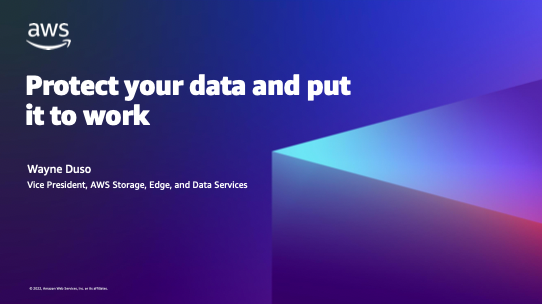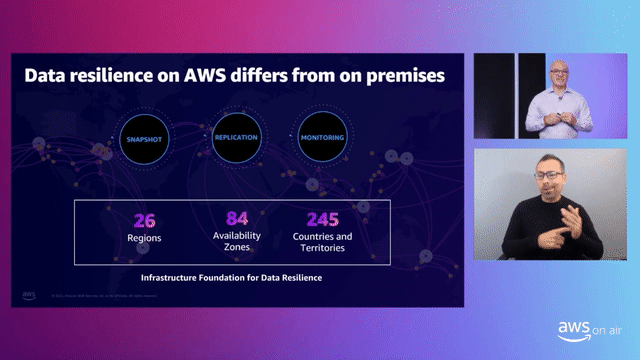Watch On-demand
About the event
Data has become a strategic asset with organizations breaking data silos to develop new insights, protecting their data with resilient architectures and recovery planning, and integrating on premises and cloud in shared workloads with modern cloud applications.
AWS offers storage services to help you make the most of your data, whether that data starts on premises or in AWS, by making it available to the applications, analytics, and advanced AI and ML workloads that are transforming how organizations and people interact with data. The built-in resilience of AWS Storage services is the foundation for organizations’ own data protection plans, and the ability to budget for storage based on frequency of use and not just capacity offers customers an option to retain more data for longer time, for innovations in the future.
This event is ideal for anyone who is eager to learn more about:
• How to prepare for AI/ML with the storage decisions you make now
• How to deliver holistic data protection for your organization, including recovery planning to help protect against ransomware
• How to do more with your budget by optimizing storage costs for on-premises and cloud data
Event Agenda
Welcome and keynote address
Click to view session information
Keynote with Andy Warfield, Vice President and Distinguished Engineer at AWS
9:00 AM – 9:35 AM PT | 12:00 PM – 12:35 PM ET
In this Storage Day keynote, you will hear Andy Warfield, Vice President and Distinguished Engineer at AWS, talk through how AWS Storage innovations help you get more from your data with Machine Learning and AI, keep your data protected, and optimize storage cost and performance when you move your data to AWS.
Storage for AI/ML
Click to view more information on sessions.
Optimize generative AI and ML with AWS Infrastructure
9:35 AM – 9:55 AM PT | 12:35 PM – 12:55 PM ET
ML and generative AI present new opportunities for businesses of all sizes. Come to learn how AWS Storage delivers high performance and scalable infrastructure for ML, and tight integration with a wide range of tools so customers can innovate faster.
Run compute-heavy workloads at cloud scale
9:55 AM – 10:15 AM PT | 12:55 PM – 1:15 PM ET
When you have workflows that need virtually unlimited high-performance compute, you want your storage to keep up with your compute. This session will lay out how AWS Storage helps you to innovate faster with ultra-fast file access for compute-intensive data processing.
Accelerate serverless app development with AWS
10:15 AM – 10:40 AM PT | 1:15 PM – 1:40 PM ET
Serverless event-driven compute services let you run infrastructure as code for virtually any type of application or backend service without provisioning or managing servers. In this session, we will discuss how AWS Storage helps you to build modern applications that adapt at scale, run analytics workloads with increased agility, and lower total cost of ownership.
Unlock the value of your data with Amazon EFS
10:40 AM – 11:00 AM PT | 1:40 PM – 2:00 PM ET
With Amazon EFS you get a serverless, elastic file system with shared storage where you pay only for the storage you use. Attend this session to discover how to better unlock and maximize the value of your data on a massive scale and access it to gain valuable data insights when you need it.
Amazon S3 Fundamentals: Deliver performance at scale
11:00 AM – 11:25 AM PT | 2:00 PM – 2:25 PM ET
Learn how Amazon S3 delivers predictable, high-throughput and low-latency object storage for your most demanding workloads. With S3, your applications can scale elastically to millions of transactions per second (TPS) and achieve terabits per second of throughput. You will learn the S3 performance characteristics, so you can tailor your storage performance to the needs of your applications.
Deep dive and demo of Mountpoint for Amazon S3
11:25 AM – 11:35 AM PT | 2:25 PM – 2:35 PM ET
You will learn how to use Mountpoint for Amazon S3 for data lake applications using file APIs to achieve high single-instance transfer rates to help save on compute costs. See a demo on using Mountpoint for Amazon S3 to access objects in a data lake, making it easy to store data at-scale and maximize its value with analytics and ML workloads.
Maximize the value of cold data with Amazon S3 Glacier
11:35 AM – 12:00 PM PT | 2:35 PM – 3:00 PM ET
The majority of the world's data is cold, but with advanced analytics and increased demand for machine learning and generative AI models, it could be put to work at any time. Learn how to use Amazon S3 Glacier to modernize your data archive and cost-effectively store long-term data without worrying about expensive tape drives or off-premises tape archival. Learn the options for ingesting and restoring your data at petabyte scale while taking into consideration cost and retrieval performance.
Data protection and resiliency
Click to view more information on sessions.
12:00 PM – 12:30 PM PT | 3:00 PM – 3:30 PM ET
In this session, learn how the Fortune 500 (F500) companies are making their business resilient to compromises in confidentiality, integrity, and availability (CIA triad). Discover how they use AWS Storage services to run game days and weather cybersecurity incidents that would otherwise result in data loss events.
Deep dive on data recovery for ransomware events
12:30 PM – 12:50 PM PT | 3:30 PM – 3:50 PM ET
Join this deep dive on ransomware recovery strategies, including the role of immutable storage across the AWS portfolio and recovery design patterns for your business-critical application data.
Optimize protection and restore data faster at reduced cost with Commvault & Amazon S3
12:50 PM – 1:00 PM PT | 3:50 PM – 4:00 PM ET
In this session, you will learn how to strengthen your cyber resilience from Commvault and Amazon S3 product leaders. You will learn how you can achieve faster restore times at reduced cost, help keep your data safe with an improved security posture, and reduce the time it takes to detect active threats. Commvault is an Advanced APN Partner and has been innovating with AWS since 2008 to help our joint customers meet business availability challenges and keep data protected.
Amazon S3 Fundamentals: Durability and availability
1:00 PM – 1:20 PM PT | 4:00 PM – 4:20 PM ET
Join this technical look at how S3 delivers the most durable storage in the cloud, for any application. The S3 architecture builds on the AWS infrastructure to address a broad range of durability, resilience, and availability requirements for applications. You will learn how our unique architecture delivers unmatched resiliency for your applications.
Amazon S3 Fundamentals: Security and access control
1:20 PM – 1:40 PM PT | 4:20 PM – 4:40 PM ET
Strong adherence to architecture best practices and proactive controls are the foundations of data security. Amazon S3 provides strong guardrails to help secure your data and granular access controls to suit any workload. Come to this session to learn about common and successful patterns for implementing access controls at varying levels of granularity and scale to maintain tight control over your data.
15th Anniversary of Amazon EBS
Click to view more information on sessions.
Amazon EBS: Reflecting on 15 years of serving customers
1:40 PM – 2:00 PM PT | 4:40 PM – 5:00 PM ET
Join us for a fireside chat with Matt Garman, Senior Vice President, Sales and Marketing at AWS as we commemorate the 15th anniversary of Amazon EBS. Matt will take the audience back in time and share the strategy and customer challenges behind the launch of the service in 2008. You will learn how the original vision for Amazon EBS has evolved to meet customers’ growing demands of cloud infrastructure, and hear from long-term EBS customer, Stripe, about their growth with EBS since Stripe was launched.
15 years of innovations with Amazon EBS
2:00 PM – 2:20 PM PT | 5:00 PM – 5:20 PM ET
Amazon EBS is celebrating 15 years of pushing the boundaries of storage performance, scalability, and reliability. Join this session to explore how Amazon EBS has evolved to support a wide range of use cases, from running high-performance databases, to securing business-critical applications in the cloud and helping customers design for high availability and resiliency.
Resilient block storage for mission-critical workloads
2:20 PM – 2:40 PM PT | 5:20 PM – 5:40 PM ET
Amazon EBS is architected for high availability, durability, and data protection. Join this session to learn EBS best practices to maximize data resiliency, including using Availability Zones to increase fault tolerance, Multi-Attach to enable high availability and load balancing, and EBS Snapshots for data protection and recovery. Discover how Amazon EBS can help you meet even the most demanding service levels for mission-critical applications.
Move to the cloud
Click to view more information on sessions.
AWS Storage cost optimization best practices
2:40 PM – 3:00 PM PT | 5:40 PM – 6:00 PM ET
Whether you’re migrating from on premises to AWS, or already in the cloud, AWS offers storage solutions that help optimize your costs and reduce TCO—all while providing storage performance that boosts productivity and accelerates business growth. The AWS Storage portfolio makes it easy and cost-effective for you to launch, run, and scale storage in the cloud, allowing you to dedicate more of your valuable time to transforming your business. In this session, we share best practice guidance you can put to use today to optimize your storage costs and extract the maximum value from your storage investments.
Migrate NAS to AWS to reduce TCO and gain agility
3:00 PM – 3:25 PM PT | 6:00 PM – 6:25 PM ET
Learn how Amazon FSx provides customers with an easy path to move legacy NAS from on-premises to AWS to gain virtually unlimited scale and improve agility while reducing TCO.
Customer interview: Phillips 66 migrated unstructured data to improve availability
3:25 PM – 3:40 PM PT | 6:25 PM – 6:40 PM ET
Join this interview to hear how Phillips 66 is going all-in on AWS File Storage from remote offsite backups, to NAS migrations, to exiting datacenters, and to scalable shared storage for virtualized environments.
Extend your enterprise data and manage with ease, featuring AWS partner, NetApp
3:40 PM – 3:50 PM PT | 6:40 PM – 6:50 PM ET
Elevate your cloud to new heights with enterprise-grade services built to easily extend to the cloud. Hear how NetApp’s integrated approach to cloud data management helps you to optimize performance and costs with continuously automated data management that extends across your hybrid cloud.
Identify and accelerate data migrations at scale
3:50 PM – 4:10 PM PT | 6:50 PM – 7:10 PM ET
Accelerate your cloud journey by moving your data to AWS quickly and securely with AWS DataSync and the AWS Transfer Family. In this session, learn how to use DataSync Discovery to identify optimal workloads to move to AWS to cut costs and increase performance, learn best practices for how to move your data faster, and hear how the AWS Transfer Family provides fully managed, highly available file transfers over protocols such as SFTP.
Hybrid cloud storage and edge compute: AWS, where you need it
4:10 PM – 4:35 PM PT | 7:10 PM – 7:35 PM ET
Whether you have remote operations or workloads that have not migrated to the cloud, learn about services that seamlessly extend AWS capabilities to support virtually any workload, almost anywhere in the world. Learn about the available service options, including AWS Storage Gateway, AWS Snow Family, and AWS Outposts.
Wrapping it up
Click to view more information on sessions.
Earn AWS Cloud Storage Knowledge badges
4:35 PM – 4:45 PM PT | 7:35 PM – 7:45 PM ET
Take advantage of the free Knowledge Badge Readiness Paths for object, block, and file storage, data migration, and data protection. Earn up to 7 verifiable badges.
Storage Day wrap-up with Jeff Barr, VP, AWS Evangelism
4:45 PM – 5:00 PM PT | 7:45 PM – 8:00 PM ET
Join Jeff Barr for his unique perspective on the announcements, topics, and customer takeaways from AWS Storage Day 2023.
Event Agenda
- Keynote
- Infrastructure Protection
- Threat Detection & Incident Response
- Identity
- Data Protection
- GRC
- Track7 Session 1
- Track8 Session 1
- Track9 Session 1
- Track10 Session 1
Keynote
Infrastructure Protection
Builders patching at scale: It doesn't have to be hard
Patching is rarely an easy thing, and patching a heterogeneous environment is even more difficult. However, with AWS Systems Manager Patch Manager, you can automate patching across multiple types of operating systems (OSs), development environments, and software packages. In this hands-on builders session, we demonstrate Systems Manager Patch Manager to create patching baselines for multiple OSs and software packages, organize instances by OS and tags, and push patches while monitoring compliance. To participate, all you need is your laptop. AWS provides an AWS account.
Data Center 360
Join us for a session about Data Center 360.
Threat Detection & Incident Response
Detecting ransomware with AWS security services
In this hands-on session, build AWS Security Hub custom insights and Amazon GuardDuty filters based on threat intelligence data. Learn how to configure log aggregation to query for known ransomware, and automatically respond to threats by turning playbooks into AWS Systems Manager automation documents. After you build, run through a scenario where you get to use these tools to detect and respond to a simulated ransomware event pattern.
Enable your security analysts
Security analysts are under constant pressure to take meaningful action against security incidents. You can cut down on response time by enabling your security operations centers to have access to critical data that gives them a better understanding of the who, what, and where during these events. Although many of security responses are automated, analysts are still required to keep expanding their scope by reviewing additional information. This session reviews services that operationalize your security team’s ability to correlate large amounts of data across multiple AWS security services by enabling your security teams in threat hunting, alert triage, and incident investigation.
Identity
Scaling access management for enterprise customers
In this session, deploy a serverless AWS SSO solution that integrates enterprise identity access and governance use cases, including organizational provisioning and periodic attestation of access, as well as solution extension for additional features. You will need JavaScript skills to make the most out of the session. You will be provided a set of AWS accounts for this session.
AuthN and AuthZ patters for serverless applications
In this session, learn different patterns and options available for authentication (AuthN) and authorization (AuthZ) of AWS serverless applications. Explore AuthN and AuthZ options based on application types such as business-to-consumer (B2C) and business-to-business (B2B). Dive deep into authorization options like JWT authorizer, IAM authorizer, and Lambda authorizer at the API Gateway layer. Also, learn about AWS services like Amazon Cognito, Amazon API Gateway, and AWS Lambda. To participate, all you need is your laptop. AWS provides an AWS account.
The journey to least privilege on AWS
We have a collective responsibility to work toward a least privilege access model. This session discusses approaches to implementing least privilege and the techniques you can use to continuously update access across your environment. You’ll learn about creating logical isolation boundaries for your data and applications using AWS accounts, applying guardrails to allow your developers to experiment, innovate safely using identity and access management policies, and right-size access permissions using AWS IAM Access Analyzer and other techniques. Bring your questions and experiences to share!
Data Protection
Use Nitro Enclaves to isolate and process highly sensitive data:
Join this builders' session to learn how to isolate highly sensitive data from your users, applications, and third-party libraries on your Amazon EC2 instances using AWS Nitro Enclaves. In this hands-on session, explore Nitro Enclaves, learn common use cases, and build and run your own enclave. Also, learn about enclave isolation, cryptographic attestation, enclave image files, local vsock communication channels, common debugging scenarios, and the enclave lifecycle. To participate, all you need is your laptop. AWS provides an AWS account.
Automation workflows with Amazon Macie
Amazon Macie is a fully-managed privacy and data security service that uses machine learning and pattern matching to help you protect your sensitive data on AWS. Customers often ask how to extend Macie to other services or applications using automation workflows, so a brief summary of Macie will be provided, followed by examples of automated workflows to meet specific use cases. Discover how Amazon EventBridge, AWS Lambda, and AWS Systems Manager can help set up automation workflows to send Macie findings to a Jira project, a Slack workspace, a custom third-party application, or Amazon QuickSight for data visualization.
GRC
Building custom frameworks with AWS Audit Manager
The AWS Audit Manager framework library is the central location where you can access and manage frameworks. You can create custom frameworks to organize control sets in a way that suits your unique requirements. In this stream, you’ll learn how to build a customized framework through the AWS Management Console. Additionally, learn from customer use cases about how to use automation with AWS SDK for Python (Boto3) to build custom frameworks at scale.
Running PCI compliant serverless workloads
Join this session to learn more about how you build a serverless payment application implemented with Amazon API Gateway, AWS Lambda, Amazon DynamoDB, and Amazon Cognito.
Track7 Session 1
Tab 7 content
Organizations today are looking to free themselves from the constraints of on-premises databases and leverage the power of fully managed databases in the cloud. Amazon RDS is a fully managed relational database service that you can use to run your choice of database engines including open source engines, Oracle, and SQL Server in the cloud. Amazon RDS automates time-consuming database administration tasks and adds capabilities such as replication and Multi-AZ failover to make your database deployments more scalable, available, reliable, manageable, and cost-effective. This session covers why you should consider moving your on-premises Oracle & SQL Server deployments to Amazon RDS and the tools to get started.
Track8 Session 1
Tab 8 content
Organizations today are looking to free themselves from the constraints of on-premises databases and leverage the power of fully managed databases in the cloud. Amazon RDS is a fully managed relational database service that you can use to run your choice of database engines including open source engines, Oracle, and SQL Server in the cloud. Amazon RDS automates time-consuming database administration tasks and adds capabilities such as replication and Multi-AZ failover to make your database deployments more scalable, available, reliable, manageable, and cost-effective. This session covers why you should consider moving your on-premises Oracle & SQL Server deployments to Amazon RDS and the tools to get started.
Track9 Session 1
Tab 9 content
Organizations today are looking to free themselves from the constraints of on-premises databases and leverage the power of fully managed databases in the cloud. Amazon RDS is a fully managed relational database service that you can use to run your choice of database engines including open source engines, Oracle, and SQL Server in the cloud. Amazon RDS automates time-consuming database administration tasks and adds capabilities such as replication and Multi-AZ failover to make your database deployments more scalable, available, reliable, manageable, and cost-effective. This session covers why you should consider moving your on-premises Oracle & SQL Server deployments to Amazon RDS and the tools to get started.
Track10 Session 1
Tab 10 content
Organizations today are looking to free themselves from the constraints of on-premises databases and leverage the power of fully managed databases in the cloud. Amazon RDS is a fully managed relational database service that you can use to run your choice of database engines including open source engines, Oracle, and SQL Server in the cloud. Amazon RDS automates time-consuming database administration tasks and adds capabilities such as replication and Multi-AZ failover to make your database deployments more scalable, available, reliable, manageable, and cost-effective. This session covers why you should consider moving your on-premises Oracle & SQL Server deployments to Amazon RDS and the tools to get started.
Multiple City Registration
-
PDF DECKKeynote: Protect your data and put it to work

-
JAN 21 2020Sunt in Culpa

-
JAN 21 2020Sunt in Culpa

-
JAN 21 2020Sunt in Culpa

-
JAN 21 2020Sunt in Culpa

-
JAN 21 2020Sunt in Culpa

-
JAN 21 2020Sunt in Culpa

-
JAN 21 2020Sunt in Culpa

-
JAN 21 2020Sunt in Culpa

-
JAN 21 2020Sunt in Culpa

-
JAN 21 2020Sunt in Culpa

-
JAN 21 2020Sunt in Culpa

-
JAN 21 2020Sunt in Culpa

-
JAN 21 2020Sunt in Culpa

-
JAN 21 2020Sunt in Culpa

Watch recordings on-demand
Storage Day keynote: Protect your data and put it to work
Data doesn’t generate value when it’s idle, and neither do your applications if their data is inaccessible. Join Wayne Duso, VP, AWS Storage, Edge, and Data Services, to learn how AWS is innovating to help you protect your data following internationally recognized guides such as the National Institute of Standards and Technology (NIST) Cybersecurity Framework, and keep your data working for you through analytics and machine learning that create value for your organization.

Session Proficiency Levels Explained
-
Level 100
Introductory
Sessions will focus on providing an overview of AWS services and features, with the assumption that attendees are new to the topic
-
Level 200
Intermediate
Sessions will focus on providing best practices, details of service features and demos with the assumption that attendees have introductory knowledge of the topics
-
Level 300
Advanced
Sessions will dive deeper into the selected topic. Presenters assume that the audience has some familiarity with the topic, but may or may not have direct experience implementing a similar solution
-
Level 400
Expert
Sessions are for attendees who are deeply familiar with the topic, have implemented a solution on their own already, and are comfortable with how the technology works across multiple services, architectures, and implementations
Quis Nostrud Exercitation
Lorem ipsum dolor sit amet, consectetur adipiscing elit, sed do eiusmod tempor incididunt ut labore et dolore magna aliqua. Ut enim ad minim veniam, quis nostrud exercitation ullamco laboris nisi ut aliquip ex ea commodo consequat.
Duis aute irure dolor in reprehenderit in voluptate velit esse cillum dolore eu fugiat nulla pariatur. Excepteur sint occaecat cupidatat non proident, sunt in culpa qui officia deserunt mollit anim id est. laborum.
Excepteur Sint
Lorem ipsum dolor sit amet, elit, sed do ut labore et dolore magna aliqua. Ut enim ad minim veniam, quis nostrud exercitation ullamco laboris nisi ut aliquip ex eaconsequat. Duis aute irure dolor in.
Featured Speakers
-

Raju Gulabani, VP of Databases, Analytics & AI, AWS
Raju Gulabani is VP of Databases, Analytics & AI within AWS at Amazon.com. He is responsible for P&<, product management, engineering and operations for Database services such as Amazon Aurora and Amazon DynamoDB, and Analytics services such as Amazon Redshift and Amazon EMR, as well as AI services like Amazon Lex, Amazon Polly, and Amazon Rekognition. Prior to joining Amazon in his current position in 2010, Raju spent four years at Google and built the Google Apps business (now known as G Suite).Earlier in his career, Raju founded an Intel backed Wi-Fi Voice over IP company as well as held engineering management positions at Microsoft.
-

Ryan Kelly, Data Architect, Equinox
Ryan Kelly is a data architect at Equinox, where he helps outline and implement frameworks for data initiatives. He also leads clickstream tracking which helps aid teams with insights on their digital initiatives. Ryan loves making it easier for people to reach and ingest their data for the purposes of business intelligence, analytics, and product/service enrichment. He also loves exploring and vetting new technologies to see how they can enhance what they do at Equinox
-

Richard Boyd, Cloud Data Engineer, iRobot
Richard Boyd is a cloud data engineer with the iRobot Corporation’s Cloud Data Platform where he builds tools and services to support the world’s most beloved vacuum cleaner. Before joining iRobot, Richard built discrete event simulators for Amazon’s automated fulfillment centers in Amazon Robotics. His previous roles include cyber warfare systems analyst at MIT and research for the Center for Army Analysis. He holds advanced degrees in Applied Mathematics & Statistics.
-

Raju Gulabani, VP of Databases, Analytics & AI, AWS
Raju Gulabani is VP of Databases, Analytics & AI within AWS at Amazon.com. He is responsible for P&<, product management, engineering and operations for Database services such as Amazon Aurora and Amazon DynamoDB, and Analytics services such as Amazon Redshift and Amazon EMR, as well as AI services like Amazon Lex, Amazon Polly, and Amazon Rekognition. Prior to joining Amazon in his current position in 2010, Raju spent four years at Google and built the Google Apps business (now known as G Suite).Earlier in his career, Raju founded an Intel backed Wi-Fi Voice over IP company as well as held engineering management positions at Microsoft.
-

Ryan Kelly, Data Architect, Equinox
Ryan Kelly is a data architect at Equinox, where he helps outline and implement frameworks for data initiatives. He also leads clickstream tracking which helps aid teams with insights on their digital initiatives. Ryan loves making it easier for people to reach and ingest their data for the purposes of business intelligence, analytics, and product/service enrichment. He also loves exploring and vetting new technologies to see how they can enhance what they do at Equinox
-

Richard Boyd, Cloud Data Engineer, iRobot
Richard Boyd is a cloud data engineer with the iRobot Corporation’s Cloud Data Platform where he builds tools and services to support the world’s most beloved vacuum cleaner. Before joining iRobot, Richard built discrete event simulators for Amazon’s automated fulfillment centers in Amazon Robotics. His previous roles include cyber warfare systems analyst at MIT and research for the Center for Army Analysis. He holds advanced degrees in Applied Mathematics & Statistics.
-

Raju Gulabani, VP of Databases, Analytics & AI, AWS
Raju Gulabani is VP of Databases, Analytics & AI within AWS at Amazon.com. He is responsible for P&<, product management, engineering and operations for Database services such as Amazon Aurora and Amazon DynamoDB, and Analytics services such as Amazon Redshift and Amazon EMR, as well as AI services like Amazon Lex, Amazon Polly, and Amazon Rekognition. Prior to joining Amazon in his current position in 2010, Raju spent four years at Google and built the Google Apps business (now known as G Suite).Earlier in his career, Raju founded an Intel backed Wi-Fi Voice over IP company as well as held engineering management positions at Microsoft.
-

Ryan Kelly, Data Architect, Equinox
Ryan Kelly is a data architect at Equinox, where he helps outline and implement frameworks for data initiatives. He also leads clickstream tracking which helps aid teams with insights on their digital initiatives. Ryan loves making it easier for people to reach and ingest their data for the purposes of business intelligence, analytics, and product/service enrichment. He also loves exploring and vetting new technologies to see how they can enhance what they do at Equinox
-

Richard Boyd, Cloud Data Engineer, iRobot
Richard Boyd is a cloud data engineer with the iRobot Corporation’s Cloud Data Platform where he builds tools and services to support the world’s most beloved vacuum cleaner. Before joining iRobot, Richard built discrete event simulators for Amazon’s automated fulfillment centers in Amazon Robotics. His previous roles include cyber warfare systems analyst at MIT and research for the Center for Army Analysis. He holds advanced degrees in Applied Mathematics & Statistics.
-

Raju Gulabani, VP of Databases, Analytics & AI, AWS
Raju Gulabani is VP of Databases, Analytics & AI within AWS at Amazon.com. He is responsible for P&<, product management, engineering and operations for Database services such as Amazon Aurora and Amazon DynamoDB, and Analytics services such as Amazon Redshift and Amazon EMR, as well as AI services like Amazon Lex, Amazon Polly, and Amazon Rekognition. Prior to joining Amazon in his current position in 2010, Raju spent four years at Google and built the Google Apps business (now known as G Suite).Earlier in his career, Raju founded an Intel backed Wi-Fi Voice over IP company as well as held engineering management positions at Microsoft.
-

Ryan Kelly, Data Architect, Equinox
Ryan Kelly is a data architect at Equinox, where he helps outline and implement frameworks for data initiatives. He also leads clickstream tracking which helps aid teams with insights on their digital initiatives. Ryan loves making it easier for people to reach and ingest their data for the purposes of business intelligence, analytics, and product/service enrichment. He also loves exploring and vetting new technologies to see how they can enhance what they do at Equinox
-

Richard Boyd, Cloud Data Engineer, iRobot
Richard Boyd is a cloud data engineer with the iRobot Corporation’s Cloud Data Platform where he builds tools and services to support the world’s most beloved vacuum cleaner. Before joining iRobot, Richard built discrete event simulators for Amazon’s automated fulfillment centers in Amazon Robotics. His previous roles include cyber warfare systems analyst at MIT and research for the Center for Army Analysis. He holds advanced degrees in Applied Mathematics & Statistics.
Customer Highlights

Epics Games’ entire analytics platform runs on AWS. Billions of game events, like player interactions on the map, their accuracy, damage taken and dealt, and what resources they are using are all sent to AWS.

Epics Games’ entire analytics platform runs on AWS. Billions of game events, like player interactions on the map, their accuracy, damage taken and dealt, and what resources they are using are all sent to AWS.

Epics Games’ entire analytics platform runs on AWS. Billions of game events, like player interactions on the map, their accuracy, damage taken and dealt, and what resources they are using are all sent to AWS.

Epics Games’ entire analytics platform runs on AWS. Billions of game events, like player interactions on the map, their accuracy, damage taken and dealt, and what resources they are using are all sent to AWS.
FAQs
Q: Where is this event?
A: This is an online event, hosted by AWS on the Twitch platform.
Q: Who should attend this event?
A: Anyone who is eager to learn more about data resiliency and protection, how to reshape your data recovery strategy to help protect against ransomware, analytics applications and using AWS storage to automate cost savings, eliminate operational complexities, and gain new insights.
Q: How much does this event cost?
A: There is no cost to attend this event.
Q: What are the prerequisites before attending the event?
A: There are no prerequisites for attending the event. We encourage attendees to browse the Storage, Database, and Analytics pages on the AWS website to get a brief overview of the services available to them.